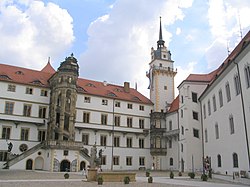Torgau: Difference between revisions
m robot Removing: lmo:Torgau |
m added multimedia |
||
| Line 47: | Line 47: | ||
* http://www.torgau.de |
* http://www.torgau.de |
||
* http://www.torgau-oschatz.info |
* http://www.torgau-oschatz.info |
||
===Multimedia=== |
|||
* [http://archives.cbc.ca/war_conflict/second_world_war/topics/1669-11552/ CBC Archives] CBC Radio reports on the Russian and American meeting at Torgau on May 1st 1945. |
|||
<br/> |
<br/> |
||
Revision as of 07:12, 24 March 2008
Torgau | |
|---|---|
 | |
| Country | Germany |
| State | Saxony |
| Admin. region | Leipzig |
| District | Torgau-Oschatz |
| Municipal assoc. | Torgau |
| Subdivisions | 4 |
| Government | |
| • Mayor | Andrea Staude (SPD) |
| Area | |
| • Total | 42.08 km2 (16.25 sq mi) |
| Elevation | 78 m (256 ft) |
| Population (2006-12-31) | |
| • Total | 18,340 |
| • Density | 440/km2 (1,100/sq mi) |
| Time zone | UTC+01:00 (CET) |
| • Summer (DST) | UTC+02:00 (CEST) |
| Postal codes | 04860 |
| Dialling codes | 03421 |
| Vehicle registration | TO |
| Website | www.torgau.de |
Torgau is a town on the banks of the Elbe in northwestern Saxony, Germany.

Outside Germany, the town is most well-known as the place where during the Second World War, United States Army forces coming from the west met with forces of the Soviet Union coming from the east during the invasion of Germany on April 25, 1945. This marked the beginning of the line of contact between Soviet and American forces, but not the finalized occupation zones. In fact the area surrounding Torgau initially occupied by U.S. forces was later, in July 1945, given over to Soviet forces in compliance with the Yalta agreement.
According to journalist Andy Rooney, who was a correspondent in Europe at the time, the Red Army raided the Hohner accordion and harmonica factory at Torgau at the time. There was nothing surprising about that, Rooney said; armies have been plundering civilian property for ages. What was surprising was that half of the soldiers in the Red Army seemed to know how to play a musical instrument. There was a woman, a singer, who had been held prisoner at Torgau during the war, Rooney said, and the Russians freed her. She gave an impromptu concert in the town square, and the sound of her voice rising above the combined accordions and harmonicas playing in unison was something one would never forget.
Sights
Sights include the historic town centre, restored since the unification, a brewery museum, the monument for the meeting of the Russian and American troops on the Elbe and a Russian military cemetery. The early Renaissance Hartenfels castle dominates the town. The chapel was built in 1544 (designed by Nickel Gromann) and combines late Gothic with early Renaissance elements. It was consecrated by Martin Luther on October 5, 1544. Brown bears are still kept in the moat.
History
The settlement goes back to a Slavonic settlement named Turguo in the shire of Neletici. There was presumably a wooden Slavonic castle located under the present-day Hartenstein castle. In the 10th century if fell under the rule of the Holy Roman Emperors, a castle and a settlement were built. A market is attested in 1119 AD. The town was located on the important trade-road between Leipzig and Frankfurt (Oder) that crossed the river Elbe at a ford east of Torgau.
Torgau belonged to the duchy of Saxony-Wittenberg. After the last Ascanian duke died without issue in 1423, the Electorate passed to the Wettin-dynasty and Torgau became residency. After the Leipzig partition in 1485, Torgau fell to the Ernestine line. The court resided mainly in Weimar and in Torgau. From 1525 onwards, Torgau became the sole residence. After the Battle of Mühlberg in 1547, Torgau fell to the Albertine line.
During the Reformation, the town council closed all cloisters in 1523. Citizens of Torgau destroyed the paintings and statues of Saints in the Churches and stormed the Franciscan monastery. After Luther had driven Andreas Karlstadt (Bodenstein) from Saxony in 1524, he enforced the expulsion of Karlstadt's followers in Torgau in 1529. Katharina von Bora, the wife of Martin Luther is buried in St. Marien, Torgau. The Torgauer Artikel, a draft of the 'Augsburg Confession' was composed by Luther, Melanchthon, Bugenhagen and Jonas in the electoral superindenture in 1530 (Wintergrün).
External links
Multimedia
- CBC Archives CBC Radio reports on the Russian and American meeting at Torgau on May 1st 1945.



